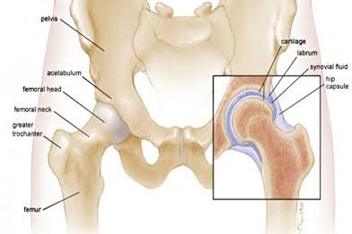Anatomy of the hip joint
The hip is one of the body's largest weight bearing joints. It is a ball-and-socket joint. The socket is called the acetabulum, which is a part of the pelvic bone. The ball is the head of femur, which is the upper end of the thighbone.
The bone surfaces of the ball and socket are covered with articular cartilage, a smooth tissue that cushions the ends of the bones and enables articulating parts to move easily with out friction.
A thin tissue called synovial membrane surrounds the hip joint. In a healthy hip, this membrane makes a small amount of fluid that lubricates the cartilage and eliminates almost all friction during hip movement.
Bands of tissue called ligaments (the hip capsule) connect the ball to the socket and provide stability to the joint.





